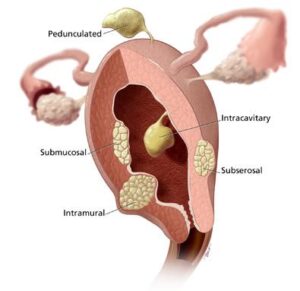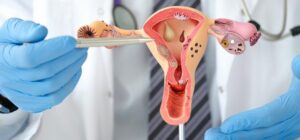Fibroid Surgery
What are fibroids?
Fibroids are the most common growths in a woman’s reproductive system. Fibroids are also known as myomas, fibromyomas , or leiomyomas . These are benign (non-cancerous) , well-circumscribed tumours that grow outside, inside or within the smooth muscle in the wall of the womb (uterus).

How common are fibroids?
Fibroids are extremely common and approximately 50% of women will have fibroids. Most fibroids are small and asymptomatic, but 40% women with fibroids will present with some symptoms.
Fibroid – Treatment options

Non – Surgical Treatments for Fibroids
Medicines can help control fibroid-related symptoms.
• Medical therapies including progestins, Mirena IUD, Oral contraceptive pills have been used to control menorrhagia (prolonged and/or profuse blood flow) in women with leiomyomas, presumably by diminishing the endometrium (endometrial atrophy).
• Tranexamic acid is an anti-fibrinolytic medication that does not contain hormones that can also be used to treat heavy bleeding. None of these medications decrease uterus or fibroid volume
• Gonadotropin releasing hormone agonists (GnRHa cause a low-estrogen (menopause-like) state which causes reduction size of the tumor and uterus. Uterine size has been shown to decrease approximately 30-50 percent after three months of therapy with these medications. GnRH agonists also stop menstrual flow (amenorrhea), allowing women with bleeding-induced anemia to increase their iron stores.
Unfortunately, long term use of GnRH agonists can lead to bone loss, however when GnRH agonist treatment is stopped it is followed by a rapid regrowth of the fibroids and of the uterus to pre-treatment volume. Therefore, the use of GnRH agonists alone for treatment of fibroids is usually limited to a short 2 to 4 months preoperative course to shrink the uterus in preparation for surgery or to improve anemia before surgery.
Uterine Fibroid Embolization/ Uterine Artery Embolization

Uterine fibroid embolization (UFE), also known as uterine artery embolization(UAE) is an alternative to surgery that involves placing a catheter through a small incision in the groin into an artery in the leg and guiding the catheter via x-ray pictures to the arteries of the uterus. Once there, the catheter is used to deliver agents that block off the blood vessels that feed the uterine fibroids. Total radiation exposure during this procedure is comparable to that in one to two CT scans. UAE does not remove uterine fibroids but causes them to shrink by 30 to 50 percent.
This treatment is preferred in women who have completed the childbearing function. Good option for intramural fibroid but not in case of subserosal and submucous fibroids.
Advantages of this procedure include no abdominal incisions and a shorter recovery time. After this procedure women may experience amenorrhea (lack of periods) depending on their age. Fibroids can recur or revascularize after this procedure, and up to 20 percent of women seek additional treatments in the five years following UAE
High intensity Ultrasound Treatment (HIFU)
HIFU is a noninvasive treatment option for uterine fibroids that destroys fibroids while preserving the normal uterus. Focused high-frequency, high-energy sound waves are used to target the proteins in fibroids, until they are destroyed. Although fibroids are treated and ultimately decrease in size, they are not removed. Women can resume normal activity within a day of the procedure; however, the long-term effectiveness of this treatment is not known.
(At present none of the facilities in United Arab Emirates offers this treatment)
Surgical Treatment Options for Fibroids

Myomectomy
When fertility is a concern and women wish to preserve their ability to have children, a myomectomy, or removal of the fibroid tumors, is the best gynecological surgery for fibroid treatment. Myomectomies can be performed laparoscopically, robotically, or hysteroscopically.
Laparoscopic / Robotic Myomectomy
Laparoscopic/ robotic Myomectomy is a procedure in which fibroids are removed from the uterus through small incisions in the abdomen while retaining the uterus. Even large and multiple fibroids can be removed with laparoscopic /robotic myomectomy. This is the best treatment option for women with fibroids who wish to have children in the future.
The advantage of a laparoscopic/robotic myomectomy over an open abdominal myomectomy is that, in a laparoscopic procedure, 3-4 very small incisions are used rather than one larger incision. The procedure can take one to three hours, depending on the number, size, and depth of the fibroids within the uterine muscle wall.
Following laparoscopic myomectomy most women can leave the hospital within 24 to 36 hours. Because the incisions are small, recovery is associated with minimal discomfort. Patients can sit up and walk around 6 hours after the surgery. Women usually resume to normal work and travel within 7-10 days.
Who should perform Laparoscopic / Robotic Myomectomy?
The procedure is very safe and effective when performed by a properly trained physician. However, many physicians today still lack the skills necessary to perform myomectomies through the minimally invasive way and therefore do not offer them to patients.
https://www.youtube.com/watch?v=WRNxPZr5pRU&t=408s
Many gynecologists have not been trained to suture with laparoscopic instruments, and some may even say that laparoscopic/ robotic surgery is not possible. It is often a good idea to get a second opinion from an expert gynecologist who performs laparoscopic/robotic myomectomies on a regular basis to see if this procedure is feasible for you.
Hysteroscopic Myomectomy

Hysteroscopic fibroid removal is a technique that can be performed for fibroids which are within or bulging into the uterine cavity (submucosal fibroid). This procedure is performed as outpatient surgery without any incisions and virtually not much postoperative discomfort.
https://www.youtube.com/watch?v=L1iI8xDe59g
This procedure is done by an Expert hysteroscopic surgeon on an “outpatient” basis under general anesthesia. It takes about 30 – 60 minutes to complete the procedure depending on the size of submucous fibroid, which is followed by a few hours of recovery time.
Hysterectomy
Hysterectomy is a surgical procedure to remove the womb. It’s the most effective way of preventing fibroids coming back. Laparoscopic / Robotic hysterectomy is the best minimally invasive way of removing uterus which offers a faster recovery than open surgery.
https://www.youtube.com/watch?v=oNH0RoYqWc0&t=278s
A hysterectomy may be recommended if you have large /multiple fibroids or severe bleeding and do not wish to have any more children.
Is there anything more I should know?
Each woman is an individual and her situation may be different from others, so requires an individual assessment and plan of management. If you are considering treating your fibroid-related problems, you need to consult a Gynecologist specialized in Minimally Invasive Gynecological Surgery so that they can offer you both non-surgical and surgical options. Your doctor will discuss your treatment options and help you make the right choice.
